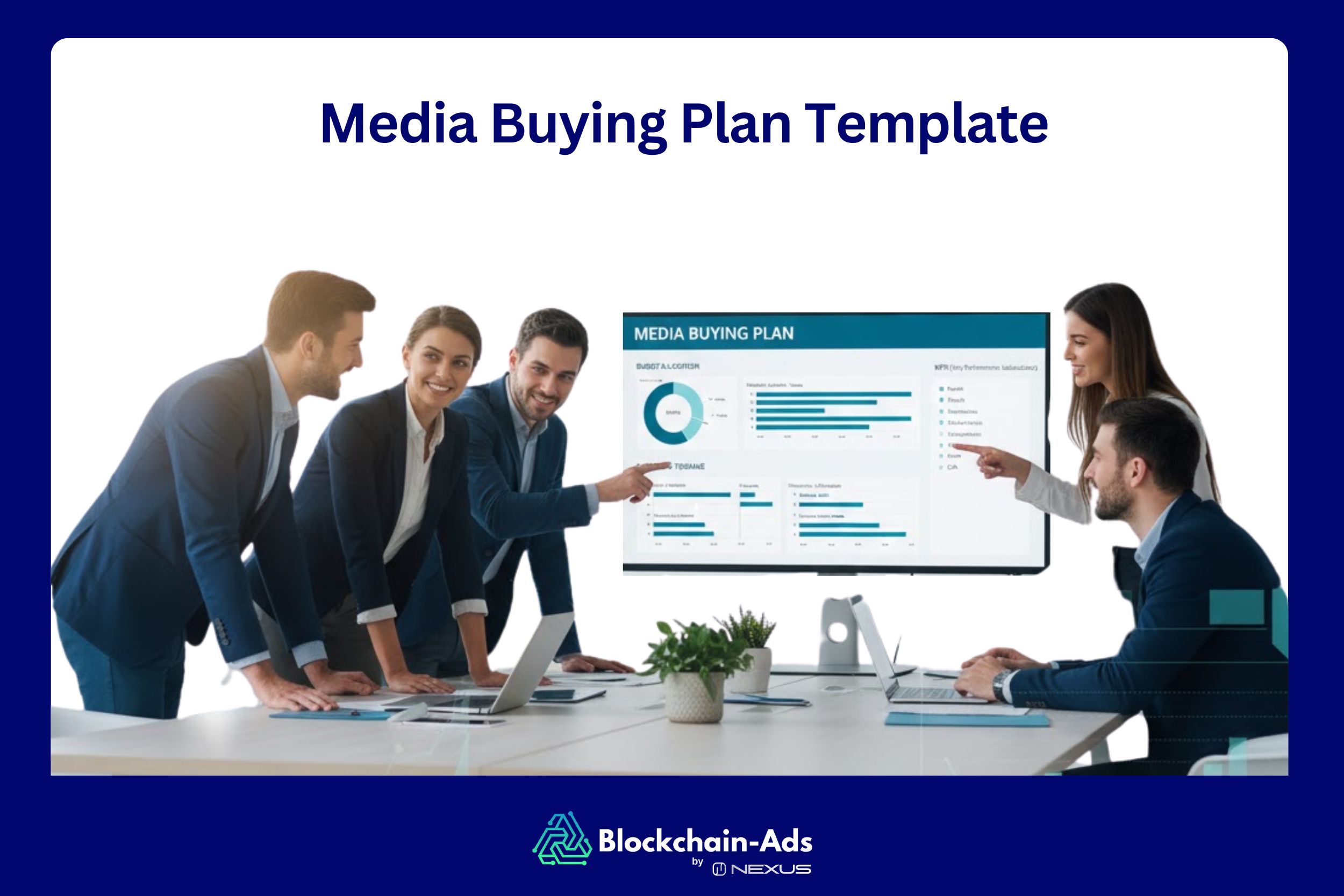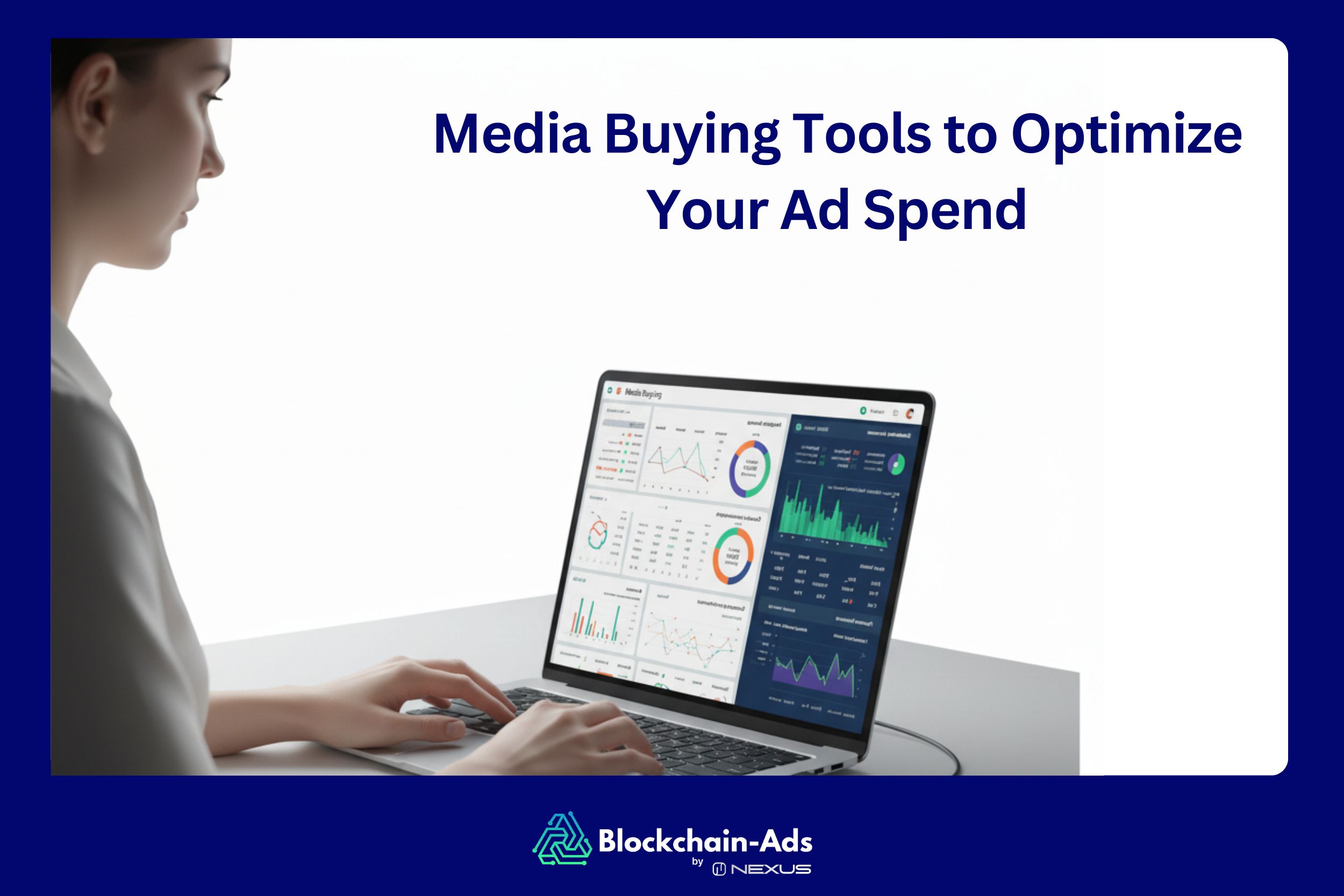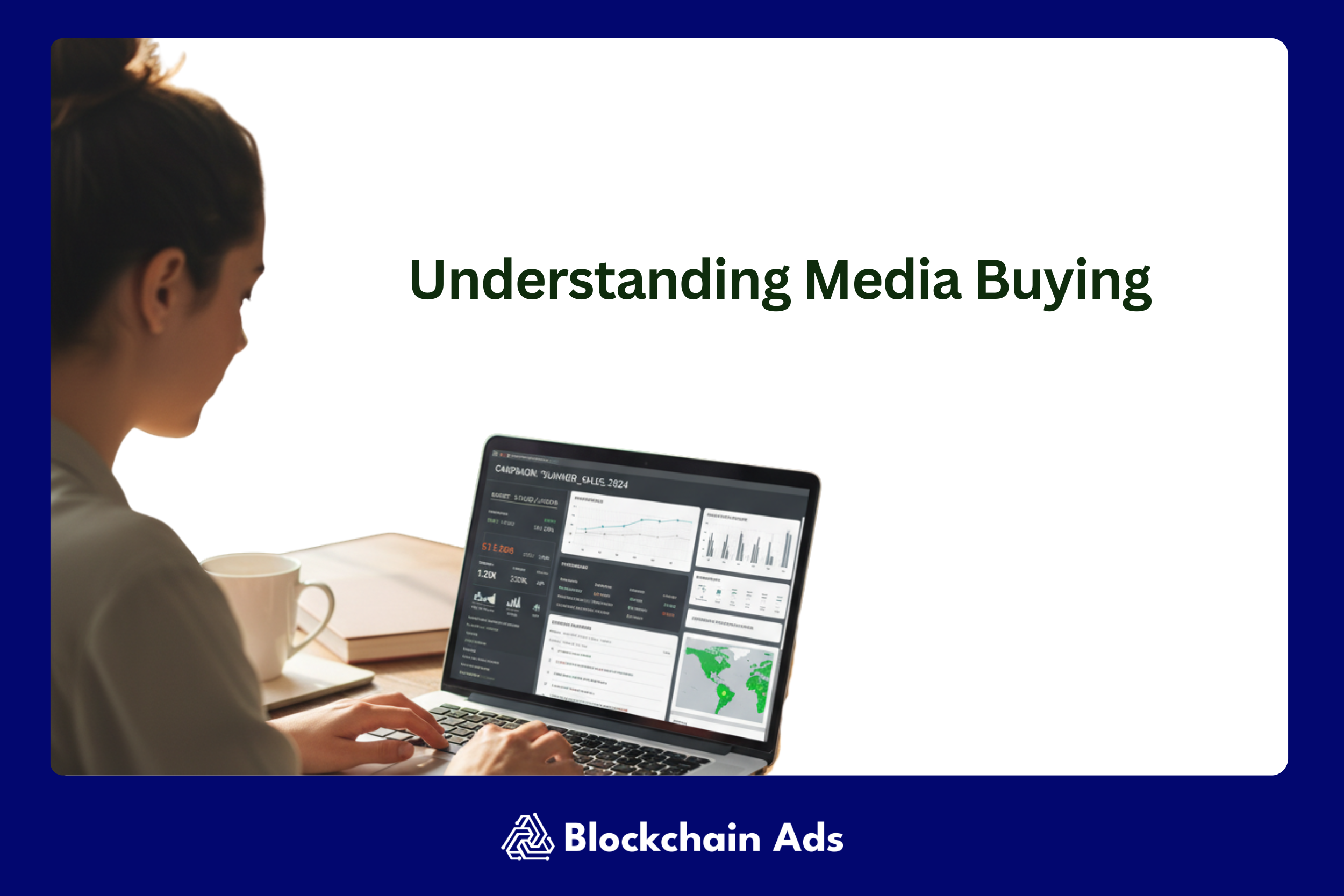Comprehensive Media Buying Plan Template + Step-by-Step Guide
Heading
- Cointelegraph Formula offers various ad formats to 8 million monthly readers across 190+ countries, leveraging its trusted name in crypto.
Many marketing managers and media planners think that a good media buying plan is only a spreadsheet full of numbers. However, it’s also the backbone of every successful advertising campaign. It decides where your money goes, who sees your ads, and whether that spend actually pays off.
With global digital ad spending expected to surpass $1.17 trillion in 2025, structure and strategy have become survival tools. A media buying plan template gives that structure. It helps teams turn messy data and budgets into clear and actionable steps. Here’s how to create a well-built template that keeps everyone aligned, from the strategist mapping the funnel to the analyst tracking ROAS.
What Is a Media Buying Plan Template?
A media buying plan template is a structured framework that guides how, where, and when to spend your advertising budget for maximum impact. Its main purpose is ad spend efficiency, ensuring that every investment delivers measurable value. For example, whether you’re managing a $10K local campaign or a $5 million cross-channel rollout, the media buying template will keep your strategy grounded, aligned with objectives, and optimized for performance.
Why Use a Media Buying Plan Template?
A media buying plan template takes the chaos out of ad spending. It replaces it with structure, accountability, and clarity.
First, a media buying process template delivers budget efficiency and a clear plan; ad spend tends to scatter across platforms without much attention to timing, overlap, or audience fatigue. Meanwhile, a good template will force you to see the big picture: how each channel contributes, where the waste lies, and probably how to reallocate funds for better returns.
Secondly, the template sharpens targeting precision. No need to spray ads everywhere and hope that something sticks. With a template, you build placements around your ideal audience. You define who they are, where they spend time, and what message resonates most.
Third, the template simplifies performance tracking. When metrics say CTR, CPM, CPA, and ROAS are logged into one place, it becomes easier to see what’s working and what isn’t. Finally, the template gives you proof of ROI. It tells a story of intentional choices and measurable outcomes, something that every decision-maker loves to see.
Key Elements of a Media Buying Plan
Let’s break down the key pieces that hold a media buying plan together.

Executive Summary
This is basically your campaign at a glance, including an overview of goals, budget, and expected outcomes. It quickly lays out what you’re trying to achieve, how much you’re spending, and what success should look like when it’s all done.
Campaign Goals & KPIs
Every campaign requires direction. Your goals should be SMART (Specific, measurable, achievable, relevant, and time-bound). Perhaps you want to increase conversion by 20% in three months. Or maybe reduce acquisition costs by half. Whatever you want, define your KPIs upfront so that everyone knows what winning looks like before the first ad goes live.
Target Audience Profiles
Here’s where the strategy gets personal with demographics, psychographics, and media habits. Who are you actually trying to reach? What makes them tick? Go beyond age and location. Look into their lifestyle, motivations, and media habits. Knowing this will let you place ads that feel less like interruptions and more like invitations.
Here, you can plan to use Blockchain-Ads' advanced targeting platform to automatically get precise audience segmentation based on behavioral data, interest patterns, and engagement signals. This ensures your ads reach users most likely to convert.
Budget Allocation
You break down spend across channels like video ads, paid search, native ads, social, display ads, and CTV. Of course, this will depend on the expected performance and past results. For example, you might allocate: native (25%), display (50%), and video (25%).
Blockchain-Ads DSPs can automate this allocation process, continuously rebalancing budgets based on real-time performance data across all channels, with Nexus AI.
Media Mix & Channel Strategy
Not every platform deserves a slice of your budget. Here, explain why you're considering certain channels and how they work together. Maybe TikTok builds awareness while retargeting ads on Google close the deal.
Thankfully, Blockchain-Ads enable precise audience segmentation across multiple channels simultaneously, using behavioral data and interest signals to identify high-intent users. This unified approach ensures your budget flows toward channels and placements that drive actual conversions, not just impressions.
Campaign Timeline (Flighting)
Timing is everything. Map out when ads will run, pause, or shift between channels. A reasonable flight schedule helps balance spending across weeks or months while aligning activity with seasonal trends, events, or product launches.
Creative Strategy & Specs
Numbers alone will never move people. This section outlines the creative direction, your messaging pillars, tone, visuals, and key deliverables. Include technical details too (file sizes, formats, or dimensions) to avoid last-minute headaches when uploading assets.
Measurement & Reporting Plan
Finally, you need a system for accountability. Define how results will be tracked, how often you’ll review performance, and what tools you’ll use. That is Google Analytics, Meta Ads Manager, or something more advanced like Blockchain-Ads.
Media Planning vs Media Buying

Media planning and media buying are two halves of one process: Strategy and execution. Media planning is the strategic phase. It is where marketers analyze data, study audience behavior, define goals, and decide which channels make the most sense for reaching them.
Meanwhile, media buying is the tactical phase. Once the strategy is finalized, buyers step in to negotiate rates, secure ad placements, and ensure that the campaigns run efficiently across all chosen platforms.
How to Create Your Media Buying Plan (Step-by-Step)
The steps below give you a foundation framework for developing a complete paid media plan.
Define Goals & KPIs
Start with clarity. What do you want to achieve in this paid marketing campaign plan? Is it boosting sales? Brand awareness? Generating leads? Or Driving website traffic? Then, match each goal with KPIs that prove performance. This is in terms of CTR for engagement, CPA for efficiency, or ROAS for profitability.
Research Your Target Audience
Next, consider your demographic. Know your audience’s habit, their favorite channels, purchase triggers, and the time of the day they’re most active online.
Set and Allocate Your Budget
Now, create a campaign budget template and allocate financial resources across different ad channels. A media plan sample can be the 70/20/10 rule, where 70% goes into proven channels, 20% into testing, and 10% into experimental.
Select Your Media Mix
Carefully pick the most effective and relevant platforms that help reach your audience. For example, you might consider pairing CTV for reach, paid social search for engagement, and search ads for intent-driven conversions.
Develop the Tactical Template
At this point, use an Excel or Google Sheets template as your control center. Make sure that there is a section for objectives, budgets, flightings, placements, and ad specs.
Outline Creative & Ad Specs
Bridge strategy and design. Each channel has its own ad format rules (image size, character limits, video durations). Lay those out here so that your creative team doesn’t waste time on revisions later.
Establish Measurement & Optimization Framework
Finally, decide which analytics tools you’ll use. This can be Blockchain-Ads DSP, Google Analytics, or Meta Ads Manager. Define reporting frequency (weekly, biweekly, monthly) and what each report must show.
Blockchain-Ads provides specialized dashboards with real-time performance metrics and blockchain-verified attribution, eliminating data discrepancies between reported results and actual user behavior.
Free Media Buying Plan Templates to Download
Basically, free media buying plan templates are great for account managers, planners, digital marketers, media managers, buyers, and more. If you’re one of them, use the following structured frameworks to help manage your budgets, messaging, and ad placement.
Paid Media Plan Template (Excel & Google Sheets)
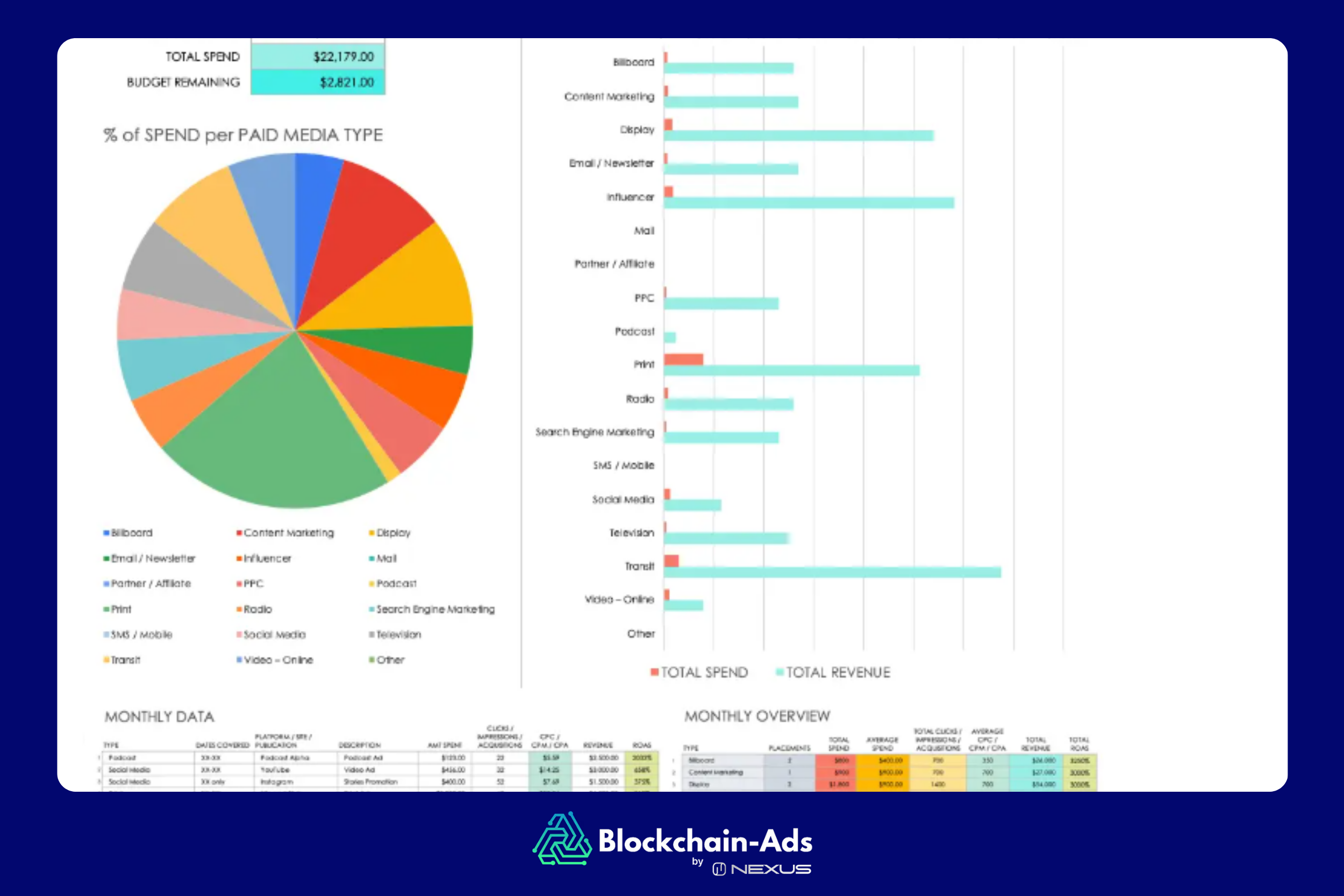
This option makes it effortless to track and manage planning and buying media. It includes fields for campaign objectives, channels, budgets, KPIs, and tracking limits. It’s easy to compare costs, impressions, CTRs, and conversions side by side. Many marketers use this paid media template as their command center for updating live data as the campaigns run.
Annual Media Plan Template
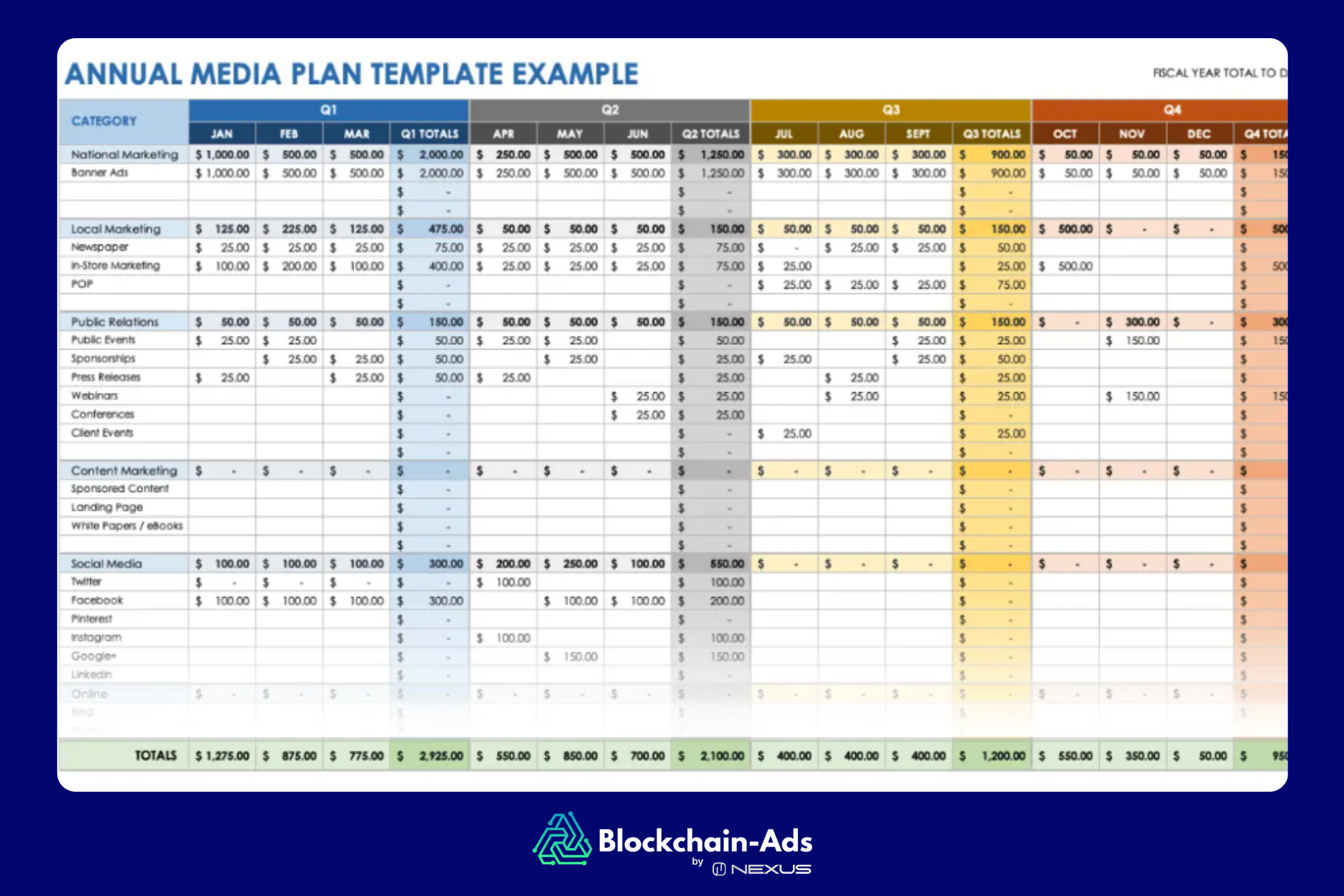
This one helps run multiple campaigns across the year. It will help you plan quarterly spends, identify seasonal trends, and visualize where the budget flows month by month. It’s possible to align product launches or big events with corresponding ad peaks.
Advertising Spend Template
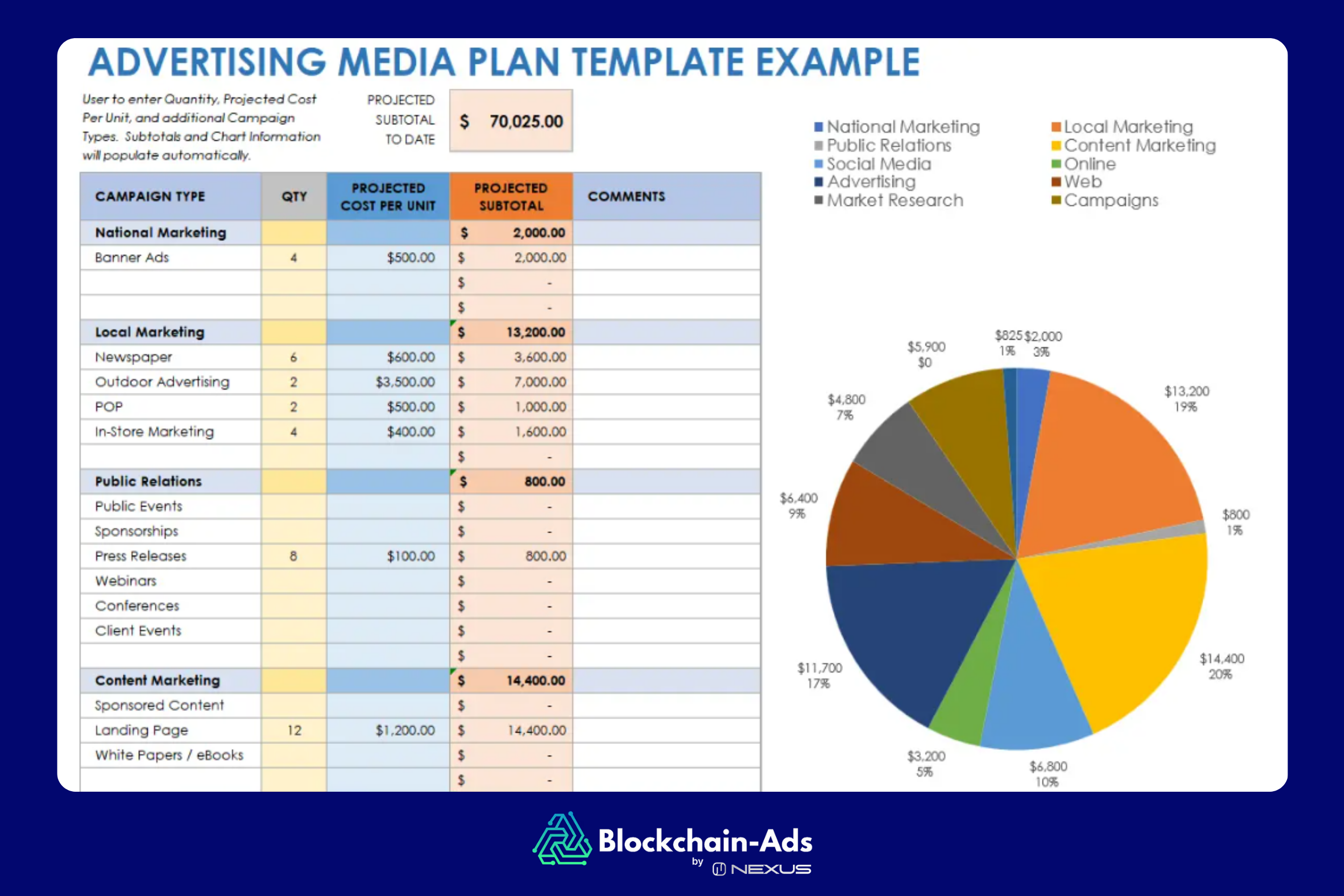
This template is designed to help you manage every dollar. What’s allocated, what’s spent, and what’s left. The layout breaks down cost by channel, campaign, and vendor. It’s ideal for national marketing, local marketing, public relations, content marketing, and social media marketing.
Digital Marketing Media Buying Template
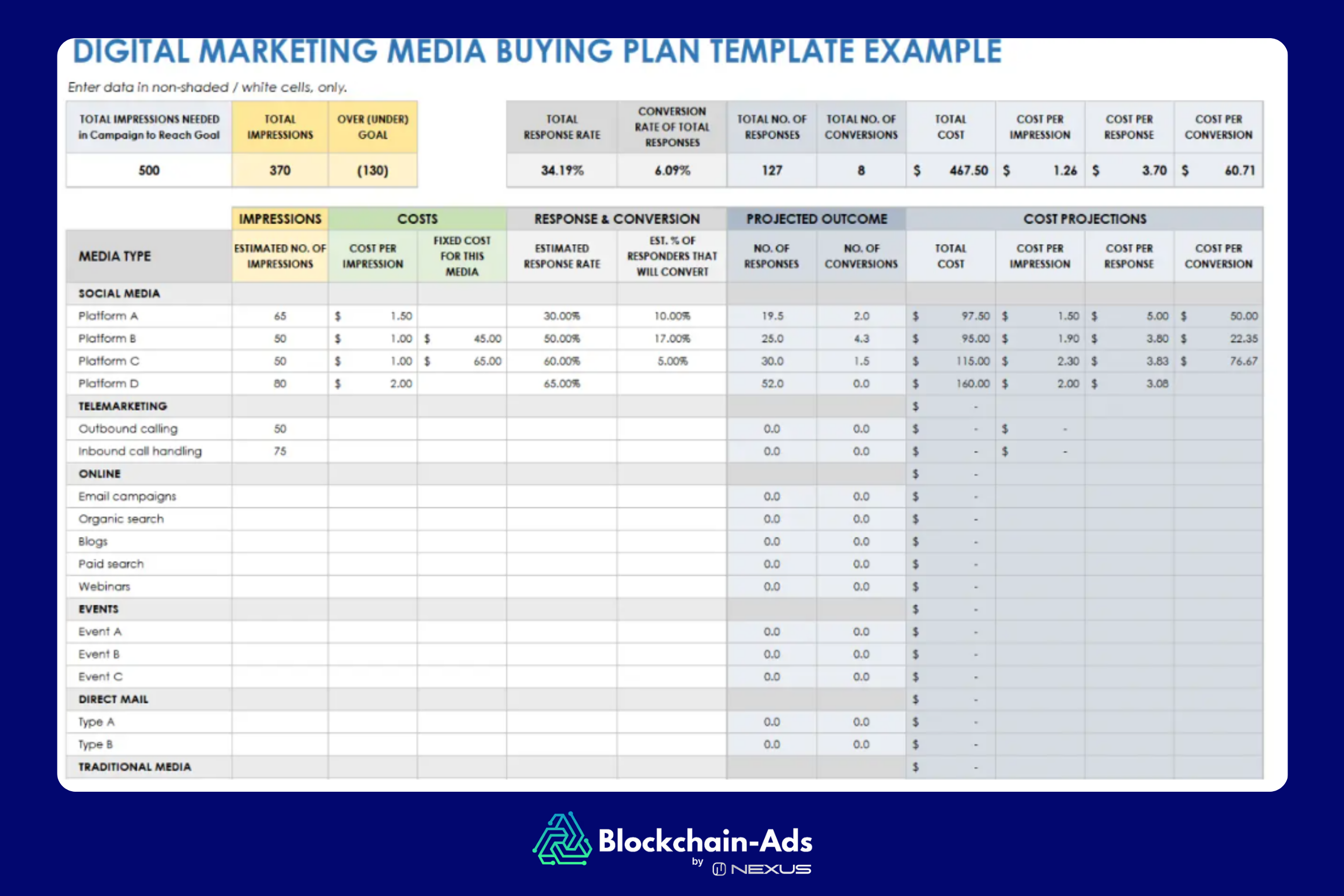
Use this option to fill in details for each digital media channel, like impressions, estimated response rate, ad placement, and costs. A digital media plan is made to monitor and measure the success of campaigns, thus perfect for marketers who care about precision.
Media Plan Presentation Template

If you want to present your plan to stakeholders, then use this template. It’s the one that turns your data into something visually clear and persuasive. The template includes sections for campaign goals, target audience snapshots, channel mix visuals, and budget breakdown charts.
One-Page Media Plan Template
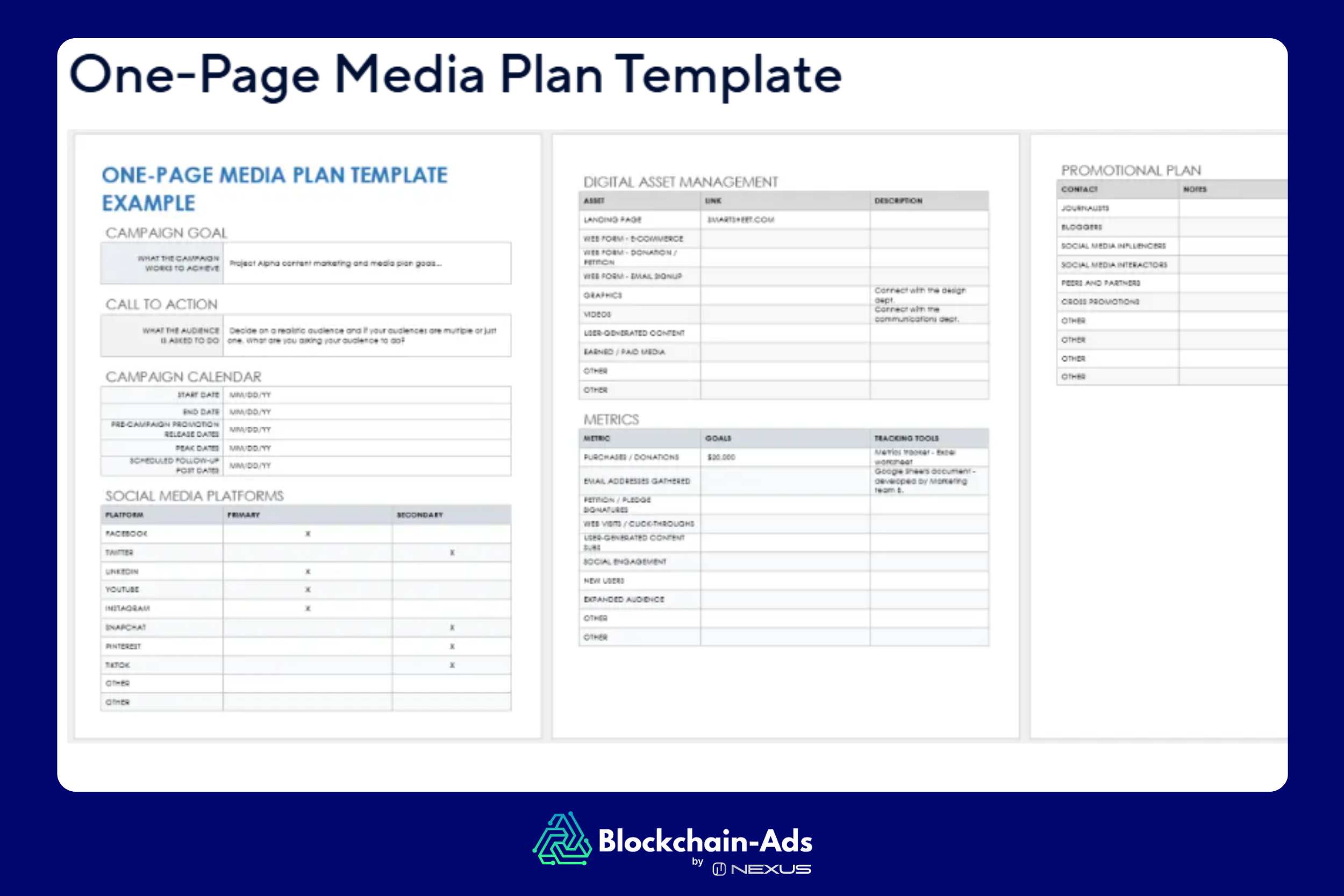
This is a one-page template that includes your entire plan. It’s generally a summary, which is perfect for quick approval or campaign overviews. The advertising plan template covers your media plan’s goal, campaign calendar, call to action, and information about the media channels that you’ll use in the campaign.
How to Use the Media Buying Plan Template in Excel/Google Sheets
After the media plan download is complete, turn those blank cells into a campaign roadmap. The good thing about Excel or Google Sheets media plans is that they’re flexible. You can tweak almost everything from the formulas and color codes to how data flows. Here’s how to get started.
- Start on the summary tab: This is where you’ll list your campaign name, overall budget, start and end dates, plus key info like CPA, CTR, or ROAS.
- Budget allocation sheet: Assign spending across channels (search, social, display, video, CTV, or even print.
- Campaign detail tab: Enter your ad sets or placements, audience targeting, bidding strategies, and creatives.
- Timeline or flight sheet: Map out when each campaign runs.
- Performance tracking section: If you’re using Google Sheets, link it directly to live dashboards or Google Data Studio. You can use formulas to calculate CTR, CPC, CPA, or ROI automatically as you input campaign results.
- Add a notes or insight tab: Use it to indicate what’s working, what’s underperforming, and what you’ll adjust next cycle.
A few quick tips before you start:
- Lock cells that contain formulas to avoid accidental edits.
- Use a dropdown for channels and campaign types to help keep data clean.
- Keep your column widths consistent
- Always version your file (v1, v2, final, final-final)
Trends in Media Buying
The media buying space is changing at the speed of technology. Every year, new platforms, privacy rules, and audience behavior reshape how marketers spend and optimize ad budgets. Here are the trends that are setting the pace for how smart advertisers plan and buy media.
Retail Media Networks
Retailers like Amazon and Walmart are turning to first-party shopper data. This is the data that’s both privacy-compliant and incredibly precise. You can expect more marketers to shift budget here now that the third-party cookies are fading away. In fact, the global RMN ad spending is over 170 billion (Statista, 2025).
The Cookieless Future & Contextual Targeting
Cookies are disappearing, and privacy-safe contextual and wallet-based targeting are redefining relevance. But rather than panic, the industry is adapting. Platforms like Blockchain-Ads are using on-chain behavior and decentralized IDs to identify potential customers. This is giving marketers accuracy without invading privacy.
Growth of Connected TV Advertising
CTV ad plan budget is projected to reach $33.35 billion in 2025 in the U.S. alone (Statista), and the upward trend shows no sign of flattening. Platforms like YouTube TV, Netflix Ads, and Hulu are already making it easier for brands of all sizes to reach viewers who no longer sit through traditional commercials.
AI & Automation in Ad Buying
Artificial intelligence is doing a lot in media buying. Today, DSPs and other platforms use AI to automate bids, predict behavior, and optimize creative performance in real time. A report by HubSpot indicates that over 77% of advertisers now rely on AI-powered automation to manage programmatic media plan campaigns. Soon, we’ll have predictive analysis that forecasts campaign outcomes before launch. Blockchain-Ads already offers this capability through their Nexus-powered AI engine, which analyzes billions of daily signals to automatically optimize campaign targeting, bidding, and creative performance in real time.
Conclusion & Best Practices
When you’re creating a media strategy template, don’t only see it as a spreadsheet. It’s more of a living roadmap for smarter spending and stronger results. Always align media choices with audience behavior, review performance data regularly, and stay alert to trends. The best campaign will always evolve through testing, optimization, and consistent tracking to maximize every ad dollar’s ROI.
FAQs
How to Create a Media Buying Plan?
Start by setting clear goals, researching your audience, selecting the right media channels, allocating budget wisely, and creating a campaign schedule. Then, finalize by outlining ad specs and tracking methods to measure performance and optimize results.
What Is Included in a Media Plan?
A great plan includes campaign objectives, target audience profiles, chosen channels, budget distribution, flighting schedule, creative requirements, and performance metrics.
Example of a Media Buying Strategy?
A fashion brand, for example, might combine TikTok influencer ads, Google Search campaigns, and CTV spots. The strategy can target Gen Z shoppers with short-form videos during the product launches. Then, retarget them with display ads during checkout season for maximum conversion.
What Are the Steps in a Media Plan?
In media plan steps, you’ll need to define your goals, research the audience, set a budget, select media channels, develop creative materials, schedule campaigns, and track results.
Qualify and get acess to Blockchain-Ads
Lorem ipsum dolor sit amet, consectetur
Quick Definition

Talk with some of our current partners
View all success stories.webp)

Reach 12M+
Engaged Web3 users across 10,000+ websites and 37 blockchains.






.png)

